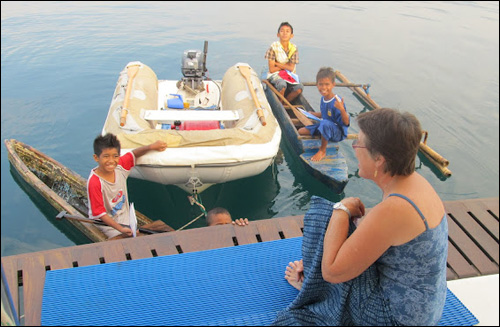
Drop a new cruiser into a busy anchorage, and one thing sure to surprise is the variety of tenders hanging behind the anchored boats. Who knew they came in such a mind-boggling array of sizes, shapes and materials?!
New cruisers who have bought pre-owned boats may have inherited the previous owner’s dinghy choice…and considered it a good deal: an accessory they didn’t have to go out and shop for right away. Cruisers who buy new are likely to choose a model on display (or on sale) at the last boat show or closest chandlery.
Chances are in neither case do they fully evaluate all the ramifications of choosing a tender for their new lifestyle. We tend to think of tenders as a means to get between the boat and shore and forget to consider so many of the other things they do for us.
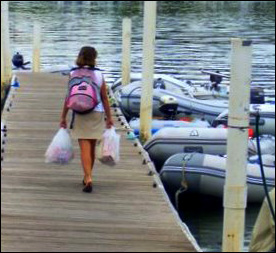 Our tenders are everyday workhorses, schlepping laundry and garbage bags to shore and groceries back or carrying heavy fuel and water jugs back and forth to rugged work docks.
Our tenders are everyday workhorses, schlepping laundry and garbage bags to shore and groceries back or carrying heavy fuel and water jugs back and forth to rugged work docks.
We ask them to land in tricky places — tidal docks, ragged wharves, barnacle- encrusted boulders, muddy mangroves, and beaches with surf – and then get back afloat when the tide goes out or the surf comes up.
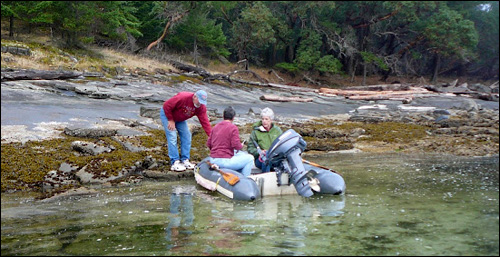
We count on them to set and retrieve second or stern anchors, run lines to trees ashore, tugboat the big boat (harnessed alongside the quarter) when the engine fails, and in some instances to double as life-rafts.
Some people even use their dinghies as laundry tubs!
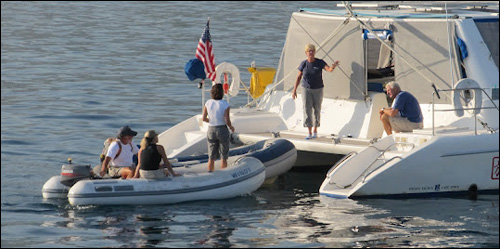
We also use our dinghies for the fun and social side of cruising. We zip around the anchorage in them visiting or raft up with friends at sunset for a happy-hour dinghy drift. We use them to go fishing, snorkeling or scuba diving on distant and sometimes exposed reefs or push them up muddy or rocky rivers to explore.
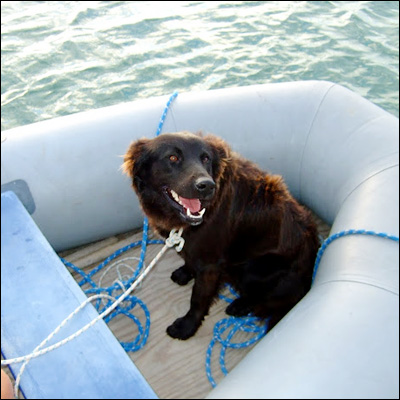 Some of us regularly use our dinghies to ferry bikes ashore, and if you have a dog? Well, there’s no more regular a commuter!
Some of us regularly use our dinghies to ferry bikes ashore, and if you have a dog? Well, there’s no more regular a commuter!
If we have kids aboard, we might want tenders able to pull boogie boards, tubes or water skis or sport a sail and let our junior captains practice tacking and gibing with some autonomy!
But sometimes, we may also want to row quietly for exercise or solitude or get around the anchorage independently. We ladies in particular want a dinghy we can handle ourselves.
So, clearly cruising dinghies are not simple people ferries. What you choose will be a compromise between what you want to do with it, where you plan to take it, how many people it will regularly carry, how you can carry it aboard (typically upside-down on the foredeck, on davits, or folded up and stowed away), and (as always!) how much you can spend.
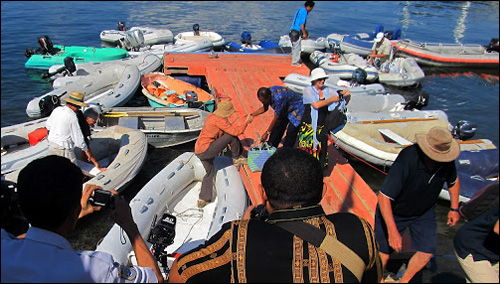
Those issues will impact how big a dinghy you need, how stable it needs to be, what material you want it to be made of, and how big or small an outboard will work for you. You may not be able to get all you need from one tender. Some cruisers carry two: one to be the work horse and another smaller one to be the “second car,” often a sailing or rowing dink or even a kayak.
Generally speaking, the more active you expect to be in your dinghy (e.g. setting up scuba gear or fishing), the more important a flat rigid floor may be; the more rugged your landings, the more important a hard bottom. The more water activities figure in your cruising plans, the more important it is to choose a dinghy easy to get into from the water; the more you travel alone, the lighter it needs to be.
The most commonly-seen dinghy in today’s cruising fleet is the inflatable. RIBs – inflatables with rigid fiberglass bottoms, single or double hulled — have grown hugely in popularity in the last decade or two because of their stability, speed through the water, and comfortable ride.
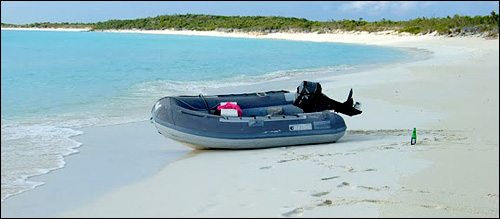
They are, however, relatively heavy for pulling up a beach or getting on deck for passages, and they collapse only as far as their rigid hull. They are also expensive.
There are also many models of roll-up inflatables, which have soft bottoms or inflatable keels. Most of these inset wood or aluminum panels to provide a firm floor, which come out should you use the option to deflate and roll the dinghy up. These dinghies also give a comfortable ride, just not quite as fast, stable or as dry as the RIBs.
A neat thing about inflatables of either style is they typically come with seats and stowaway oars, often a small anchor locker, plus lifelines, towing and lifting eyes and various handles helpful for pulling the boat ashore or getting back aboard out of the water. Not all inflatables position these the same way, and some configurations are more useful than others.
A major issue with cruising inflatables is the material it is made from. If you plan to cruise the tropics and want an inflatable, be sure to choose one made of Hypalon® fabric. Inflatable dinghies made from PVC have a poor record for holding up in tropical strength UV.
A vulnerability of inflatables in general is their susceptibility to punctures from anchor flukes, spearguns, and sharp projections on docks. Many owners make Sunbrella® covers to protect pontoons, but even so it’s important to choose a model that has multiple air chambers and to carry a patch kit.
Also, the bigger the pontoons, the drier the ride, but the harder it is for swimmers to climb back aboard from the water.
The main alternatives to inflatables are rigid fiberglass dinghies. The most traditional of these are rowing dinghies, some of which can double as sailing dinghies. This flexibility, the fact that they are virtually indestructible, as well as their lower cost make them popular with cruisers on a tighter budget and with families as a second dinghy. Rigid dinghies, however, are not as stable as inflatables nor as buoyant. If they fill with water (from waves or rain), they will sink.
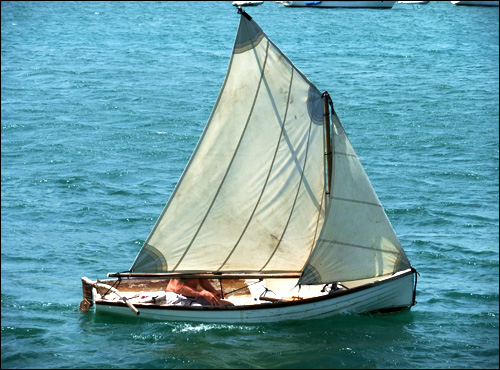
You occasionally see skiffs and Whalers behind bigger cruising boats. These are typically faster and drier than even RIBs and indestructible like rigid-hulled dinghies, but thanks to inbuilt flotation, relatively unsinkable. The reason you don’t see more is their cost and the difficulty of carrying them aboard. Hanging them from davits is too much weight off the stern for most cruising boats.
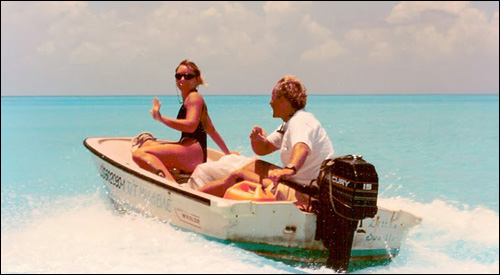
For singlehanders, the most important criteria for a tender is that it be one they can launch, handle or beach solo, not to mention fit onboard often smaller motherships. These are the cruisers whose tenders are kayaks, rubber rafts, tiny inflatables, Porta-botes®, or small rowing dinks.
Is bigger better? The bigger the dinghy, the bigger the outboard, the more load you can carry – people or gear (like scuba gear) – and the farther and faster you’ll be able to go.
HOWEVER, the bigger the dinghy (and its outboard), the more fuel you need to run it and the heavier the dinghy will be for hauling up a beach, for towing, or for hoisting aboard. Also, the bigger the dinghy the harder it can be for one person (particularly the slighter and less strong members of the crew) to manage.
In the final analysis, whatever dinghy you decide you need, it must also fit your boat. If you can’t fit it on the foredeck, collapse and stow it, or hang it from davits without overweighting your stern, then it is not the right tender for you.
All this is a lot to consider, but choosing the right dinghy is just the first step.
Next month we will look at considerations for choosing the right outboard.
Photos: Thanks to Kathy Parsons, HALE KAI.
This article was published in the April 2012 issue of Latitudes and Attitudes.
Related articles on this website
- Choosing the Cruising Dinghy’s Outboard (Admiral’s Angle Column #66)
- Accessorizing the Cruising Dinghy (Admiral’s Angle Column #67)
- Dinghy Driving 101 (Admiral’s Angle column #11):
Driving the dinghy is a real skill worth learning early to support confidence and avoid dependence. - Ask your questions: Dinghy choice: RIB or hard dinghy?
